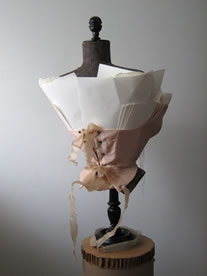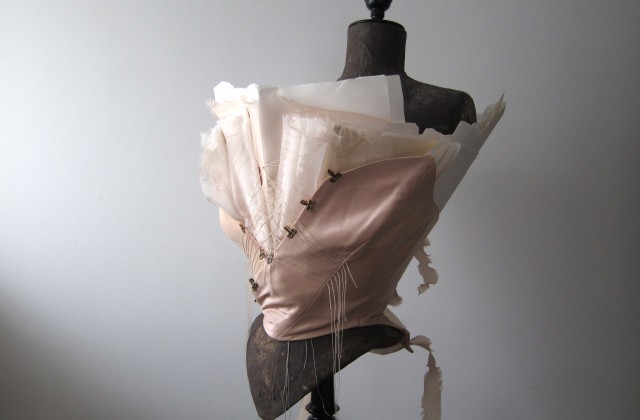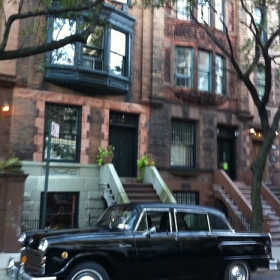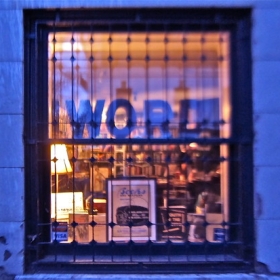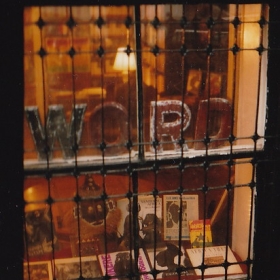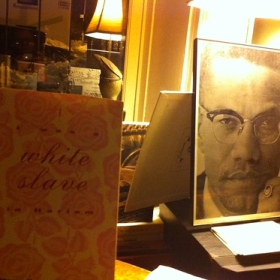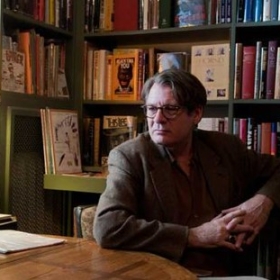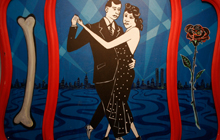Old Fashioned Romance: A Couturier’s Tale.
by Ashley Davidson / Photos: Seth Tillett.
Vanity, that most punishable of vices, so often exposes the one thing we most intend for it to conceal: our selves. The couturier serves as wizard, historian and heretic, harnessing vanity to create deities from the detestable, while disguising the average as extraordinary. Above all, the couturier is a storyteller. Unfortunately, it seems that we have forgotten how to read.
Camilla Huey is this breed of couturier. She is the mistress of the House of Execution, one of New York City’s few remaining couture houses, aptly named on September 12, 2001. Born to the great State of Louisiana, she inherited a Southern reverence for history and a knowing respect for the art of gossip long before her training began as an artist of fashion. Camilla’s life is threaded with stories shared and created while dressing the last of the Great Dames, theater starlets and socialites who have passed through The Island of Manhattan on their way to infamy.
Camilla has the ability to tell a story through exquisitely constructed fashion, thoroughly blurring whatever lines may exist between art, invention and couture. Simply put, she brings dreams to life in physical form. She is currently working on a new story apart from the red carpet and Broadway stage, which will be realized later this year as her first solo exhibition. The installation is comprised of sculptural corsets, each representing one of six remarkable women who share in common one of the most entertaining scoundrels in all of New York.
The particular scoundrel of reference was a young orphan and runaway who studied law, became a war hero and a notorious ladies’ man, climbed the political ranks of the United States government, got away with murder, fell in love and married an older woman who soon left him a widower; who was arrested on the Mississippi River disguised as an Indian in a canoe while making his way to Mexico, and was then banished for treason, exiled to Europe, grieved at the loss of his only daughter to pirates, and eventually returned home to marry one of the richest widows in New York, who, according to Camilla, was “born a bastard, lived a whore, and died a recluse.” (Yes, it’s all true.) The man was Revolutionary War hero and former Vice President Aaron Burr, best known today for killing Alexander Hamilton in a duel.
Only in New York? Perhaps not, but this is where it all went down… New York remains a city of opportunity and catastrophe; a city that draws together the ambitious and adventurous onto a seemingly fictitious stage where anything can happen.
Camilla would know. Arriving in New York as a fresh graduate off the train from Memphis, she would come to dress the likes of Katherine Hepburn, Jacqueline Kennedy Onassis and Oprah, and would outfit the sets of Broadway productions including Beauty and the Beast, as well as the Metropolitan Opera. She has continued to execute the couture pieces of Donna Karan, Ralph Lauren and Zac Posen, to name a few. Camilla knows couture inside and out, and through her stories I’ve come to realize that the couturier has yet another role – that of the psychiatrist or priest who hears all confessions and hides a multitude of sins from the confines of her fitting room.
However discreet, couture – that most personal and symbolic of fashions made just for the individual – gives clues about the person behind the veil; their dreams and fantasies combined with their secrets and earthly reality. In this spirit, Camilla’s art reminds us that the personal objects we surround ourselves with and cherish tell the private story of who we are better than any biographer could.
As a couturier and artist, Camilla thrives on these stories. Her world is a menagerie of unique characters whose stories are so rich that you can be sure she’ll never run short on material. She is married to Kurt Thometz, a connoisseur of literary and social history who began his career as a private librarian by curating the library of Diana Vreeland. Camilla and Kurt live in a brownstone in the furthest reaches of Harlem, directly across the street from the Jumel Mansion, which is the oldest residence in the borough of Manhattan. While this Mansion may best be remembered as Washington’s headquarters during the Revolutionary War, its most riveting residents were certainly the bastard/whore/recluse Madam Eliza Jumel and the scoundrel Aaron Burr, whose lives are as ludicrous and brilliant an example of New York adventure as I’ve ever heard.
Camilla has been immersed in the world of Jumel for the past decade, and it’s no wonder she’s been so captivated.
“As a Southerner, you are brought up to revere the past,” Camilla asserts from the fitting room of her atelier, surrounded by antique dress forms, rare books and treatises on fashion.
Yet much of written history is blurred by politics, vanity or propriety, and as Camilla puts it,”the facts don’t add up to the truth.”
“Because so much of what we gain from (historical) documents tells us so little about who a person was, I prefer using the genre of feuilleton, a hybrid of gossip, melodrama and weird news. Gossip tells me more about a person’s point of view, sense of humor and nature and of those surrounding that person.”
If truth exists somewhere between the lines of written history, it is especially difficult to interpret the lives of women from what little has been recorded about them. Camilla began adapting her interest in powerful women from the footnotes of history over a year ago with sketches of their intimate wear: something much closer to the body, more honest and real than any written statement. “It seemed to me only possible to construct something akin to (an individual’s) intangible presence by bringing together elements representing their tastes, their desires, wit and humor in something personal.”
Camilla’s installation of corsets captures the dreams and uncertainty of the women most influential to the exceptional and oft forgotten legacy of Aaron Burr. The corsets are made from a wide range of carefully selected and exquisite materials that reflect the diversity of the women, as well as the nuances and titillating details that brought them to infamy. Among the completed pieces is the voluminous corset representing Theodosia Burr, Aaron’s first wife and great love.
Theodosia was a highly educated and wealthy woman who cleverly balanced her station as both a Colonial daughter and the wife of a British Loyalist. She shrewdly played both sides of the Revolutionary War by lodging Tory generals in one house within her holdings, and General Washington’s officers in another. It was during this time that she met the young and dashing Aaron Burr, who would marry her within a year of her husband’s death, thus securing her lands from confiscation.
She was the intellectual equal of Burr, and their remaining private letters are a testament to their romance. In fact, they were a rather sexy couple – the intellectual and Revolutionary version of Ashton and Demi, pre-divorce. Burr and Theodosia had one daughter together before her death 11 years later (though he was thought to have had other children outside of the marriage).
Early in their relationship, Theodosia expressed desire for the freedom to explore her own non-domestic interests without interruption. Burr encouraged her to take the time and space for this in a “room of her own,” and it was with this sentiment (made famous a full century later by Virginia Woolf) that Theodosia was liberated to expand on her own writing.
Camilla channels that eruption of intellectual passion through a pink silk taffeta corset, bursting from its silk bindings and reinforced with bookbinding threads. Handmade cotton papers representing Theodosia’s body of work overflow from the corset’s open form, and a ribbon of bias cut silk organza with feathered edges tumbles from the spine of the corset, delicate as a whisper. It’s a moving sight of exquisite execution, and you can feel the spirit of the woman and the romance personified by the object when viewing it.
In stark contrast to Theodosia was Aaron Burr’s second wife, Eliza Jumel, the scandalous prevaricator who divorced Burr on his deathbed. Eliza was a wild card with a rags-to-riches story that began in Rhode Island where she worked the streets with a monkey perched on her shoulder. At age 14, she claimed to have given birth to the illegitimate son of George Washington, and was then sent to Europe by an anonymous benefactor and found that her street education was complimented with something a bit more formal. She returned to New York City where she set forth as an aggressive social climber, audaciously spreading tales of Napoleon’s great admiration for her (the accuracy of her stories has never been verified).
Upon successfully securing the role of wife to Stephen Jumel, the richest man in New York, Eliza became both Madam Jumel and untouchable in the eyes of society. She married Burr only months after the mysterious death of Stephen Jumel, and also quite late in Burr’s life when he had returned from exile after being accused of an act of treason wherein he had allegedly utilized U.S. provisions in a failed attempt to become the Emperor of Mexico. After Burr’s death, Madam Jumel would live out her days as a recluse within the confines of her mansion on 160th Street.
With Madam Jumel, then and now, one is left anxiously wanting more. It is with great anticipation that we await Camilla’s interpretation of the famed tart.
Corsets created with the couturier’s hand in the spirit of animated narrative and gossip bring these stories back to life and remind us that the personal object – fashion – carries a meaning beyond the superficial. In her emerging exhibition that visualizes the illustrious lives of six bold women who shaped a much forgotten history, the artist cunningly expresses that Southern reverence for the dead and for a story lived by someone else. This reverence is combined with a knowing respect for the history of New York which, although rich and entertaining, is constantly demolished or ignored in the pursuit of modernity. It ties in with our present reality through the fact that we are now at a social and political crossroads of protest and debate, when life’s uncertainty is unbearable, and the fate of all is suspended.
Although our Constitution is established and our wilderness now tamed, in many ways we live in a time as sensational and uncertain as the days of Aaron Burr. But it’s not all tragic! History can be lived as well as it can be imagined, and nothing captivates the imagination quite like fashion and gossip.
“Burr,” the exhibition by Camilla Huey will be completed in 2012. The venue has yet to be determined.
